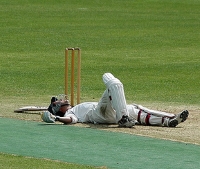Cricket Practice Tips: Dealing with the Problem of Poor Net Bowlers
 Have you ever suffered from this issue: You turn up to a net, only to find the bowler or batter you are up against is not up to standard?
Have you ever suffered from this issue: You turn up to a net, only to find the bowler or batter you are up against is not up to standard?
Sure, Jimmy is a fully paid up member of the club and he has the same right to come to practice as you. However, that doesn't change the fact that you face his 55kph bowling with every third ball in the side netting.
It's also no good for Jimmy, as when he does bowl a decent length ball you smash it. You have just wrecked the confidence of a youngster, you bully.
How do you both get a good practice instead?
The natural answer is to train players of similar standards on different days. The seriously skilled players get together on Tuesday and the occasional recreational tryers stick to Thursday.
But that rarely works out.
What if your star bowler can't make Tuesday because of work and can only come on Thursday? You can't turn her away and she will be wasted - or even dangerous - bowling to lesser skilled batsmen. The system only works if the right people can make the right time. That's rare in non-professional cricket.
At my club we have that exact issue. So, here is how we cater for mixed abilities while developing everyone, whatever the standard.
Sector off
Break the large group into roughly equal abilities. Group sizes don't have to be equal. Then get players working on different things in different areas. On an outfield you can get three to five sectors to work in.
For example; you can have a fielding station, a batting drill station and a bowling station. At each station the drill difficulty, intensity and fitness requirement can match the players. This is easily done by someone sensible upgrading or downgrading the drill to make it harder or easier.
A simple close catching drill could be pairs throwing back and forth (for learners), throws off a Katchet for better players and nicks off a bat for the advanced ones who need real pace. There is always a way to adjust a skill practice.
Bowling machine
Bowling machines might be like Marmite, but they are perfect for mixed ability batsmen.
You can easily have an average 12 year old face slow balls, then crank up the pace to 80mph for a 1st team player in a few moments. The accuracy of the machine allows a great deal of volume for technical work at an acceptable pace. You just need someone sensible to man the machine and you are away. You can easily keep three or four batters engaged in a session at once, and all can face a lot of balls in a short period of time.
Combine it with PitchVision and you can easily have video analysis and data on how technique adjusts to different speeds, lines, lengths and deviations.
Naturally, there are limitations. It's not the same as facing real bowlers, as is well documented. If it's overused you start seeing players very good at hitting balls from the machine without getting better at hitting real bowling. This is not a deal breaker as volume has to be very high before the effects kick in.
Technical drills
The final way to keep everyone happy is to work on technique.
Everyone can do with technical work from the total beginner to the International cricketer. For mixed groups this is easy because technical drills can be done with anyone. You can work together with batting buddies. You can pair up and do your bowling drills. You can even throw low intensity catches to each other simply to make sure you are getting in good positions.
The options are endless as soon as you drop the pace to work on body position. And everyone can benefit from that approach.
So, next time you are at training and feel like you are not getting realistic practice because of the guy at the other end, try one of these approaches instead, and let me know how you get on.
- Login to post comments

